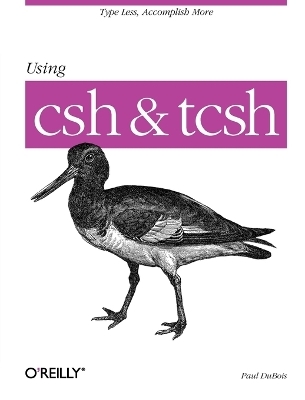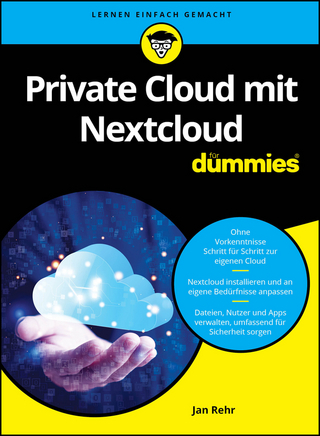
Using csh and tsch
O'Reilly Media (Verlag)
978-1-56592-132-0 (ISBN)
If you use UNIX, you probably use csh to type commands even if you've never heard of it. It's the standard shell (command line) on most UNIX systems. tcsh is an enhanced version that's freely available and highly recommended. Using csh & tcsh describes from the beginning how to use these shells interactively. More important, it shows how to get your work done faster with less typing. Even if you've used UNIX for years, techniques described in this book can make you more efficient. You'll learn how to: * Make your prompt tell you where you are (no more pwd) * Use what you've typed before (history) * Type long command lines with very few keystrokes (command and filename completion) * Remind yourself of filenames when in the middle of typing a command * Edit a botched command instead of retyping it This book does not cover programming or script writing in csh or tcsh because the tasks are better done with a different shell, such as sh (the Bourne shell) or a language like Perl.
Paul DuBois is a programmer at the Wisconsin Regional Primate Research Center at the University of Wisconsin-Madison. He leads a quiet life with few interests outside of family, church, and programming.
Preface Part 1: Learning the Basics Chapter 1: Introduction Using the Examples Selecting a Login Shell Before You Read Further Chapter 2: A Shell Primer Entering Commands Command Input and Output Files and Directories Combining Commands Running Commands in the Background When Do Spaces Matter? The Shell Startup Files Chapter 3: Using the Shell Effectively Using Filenames Reusing and Editing Commands Creating Command Shortcuts Using Command Substitution Navigating the File System Using Your Prompt Using Job Control Part 2: Becoming More Efficient Chapter 4: The Shell Startup Files Startup and Shutdown Files Getting To Know .cshrc and .login Modifying .cshrc and .login Using Variables Organizing Your Startup Files The .logout File Chapter 5: Setting Up Your Terminal Identifying Your Terminal Settings What the Settings Mean Changing Your Terminal Settings Did Your Terminal Stop Working? Chapter 6: Using Your Command History The History List Reviewing Your History Using Commands from Your History Event Specifiers Word Designators Event Modifiers Making History Persist Across Login Sessions Chapter 7: The tcsh Command-Line Editor Editing a Command Command Key Bindings emacs Editing Mode vi Editing Mode Examining and Modifying Key Bindings Chapter 8: Using Aliases To Create Command Shortcuts Defining Aliases Uses for Aliases Using Sets of Aliases Chapter 9: File-Naming Shortcuts Using Filename Patterns Using {} To Generate Arguments Directory Naming Shorthand Chapter 10: Filename and Programmed Completion Using Built-In Filename Completion Programmed Completions Syntax of the complete Command Displaying and Removing Programmed Completions When Programmed Completions Do Not Apply Chapter 11: Quoting and Special Characters Special Characters The Shell's Quote Characters Referring to Files with Problematic Names Passing Special Characters to Commands Using Partial Quoting Quoting Oddities Chapter 12: Using Commands To Generate Arguments Command Substitution Repeating Substituted Commands Deferred Command Substitution When To Avoid Command Substitution Chapter 13: Navigating the File System Moving Around Working in Multiple Locations Letting the Shell Find Directories for You Using Aliases and Variables To Move Around Chapter 14: Keeping Track of Where You Are Types of Location Reporting Displaying Your Location in the Prompt Display Your Location in the Window Title Putting It All Together Displaying Other Types of Information Chapter 15: Job Control Job States Obtaining Job Information Changing a Job's State Other Applications of Job Control Job Control and Window Systems Part 3: Appendixes Appendix A: Obtaining and Installing tcsh Obtaining the Source Distribution Build the Distribution-Quick Instructions Build the Distribution-Detailed Instructions Testing and Installing tcsh Allowing tcsh To Be a Login Shell Appendix B: csh and tcsh Quick Reference Command Structure Startup and Shutdown Files Variables Special Characters Command History Moving Around the File System Aliases Filename Completion Programmed Completion Job Control Command Editing in tcsh Appendix C: Other Sources of Information Documents Newsgroups Mailing Lists Index
| Erscheint lt. Verlag | 9.10.1996 |
|---|---|
| Verlagsort | Sebastopol |
| Sprache | englisch |
| Einbandart | kartoniert |
| Themenwelt | Mathematik / Informatik ► Informatik ► Betriebssysteme / Server |
| Mathematik / Informatik ► Informatik ► Web / Internet | |
| ISBN-10 | 1-56592-132-1 / 1565921321 |
| ISBN-13 | 978-1-56592-132-0 / 9781565921320 |
| Zustand | Neuware |
| Informationen gemäß Produktsicherheitsverordnung (GPSR) | |
| Haben Sie eine Frage zum Produkt? |
aus dem Bereich


